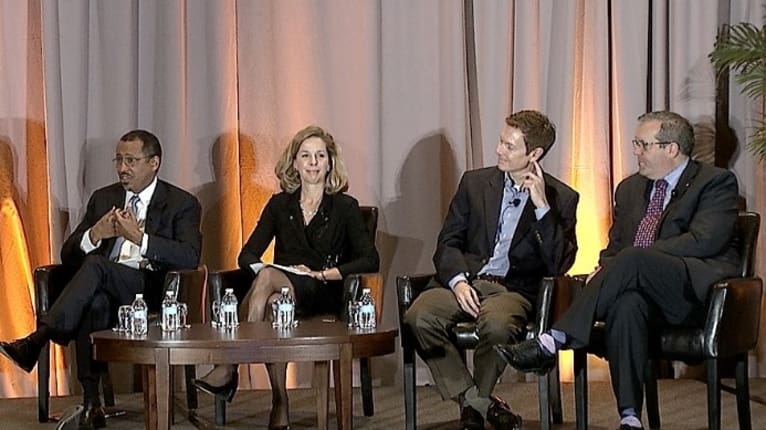
Would 50 benefit plan options be too many?
Workers' ability to create a personalized benefit package—with greater flexibility to alter their selections outside of an annual open enrollment period—is coming, corporate benefit leaders predict.
They shared their forecasts during a panel discussion at the American Benefits Council's 50th Anniversary Symposium, held recently in Washington, D.C.
"To enhance shareholder value, employers need to hire the best people for every job," said Kevin Avery, manager of federal government affairs for energy firm ConocoPhillips. "To hire the best people possible, we have to meet their needs" for paid-leave policies, flexible scheduling and work/life balance, he noted. That can range from providing student loan assistance to helping employees care for aging parents.
"It's becoming more important for employers to fill gaps left by common or mandatory benefits such as time off under the Family and Medical Leave Act (FMLA)," he noted. "Our employees are turning to us because they need paid time off—how many of you can go 12 weeks without being paid?" he asked, referring to the amount of unpaid leave provided under the FMLA.
Rise of the Gig Economy
As the definition of an employee changes, so too will workers' benefit needs, said Jennifer Graham-Johnson, SHRM-SCP, chief HR officer at WestRock Co., a manufacturer of paper and packaging products.
"As the gig economy expands, people will be dropping in and doing work as a contractor and then moving on," she said. For many of these workers, forgoing full-time employment will be "a choice made for flexibility and freedom." Also expect shorter tenures among full-time employees, she advised, saying, "It's not a failure if someone leaves after three to five years to seek a new experience." However, "you still, need to train these employees to take full advantage of their contributions while they're with you."
Employees will increasingly expect to be able to customize their work schedules, pay periods and benefit packages, Graham-Johnson said. "People want more 'life' in the work-life equation," she noted.
"Employers should empower all employees to be creative," said Fred Thiele, general manager of global benefits at Microsoft. "We're looking at how over the next three to five years we can adapt our compensation and benefit plans to meet the needs of those who choose to participate in the gig economy, so the company can continue to thrive in the future."
Thiele advised HR leaders to "seek to be an employer of choice and 'gig' of choice," by determining which jobs can be parsed out to gig workers, such as customer support, and offering full-time employees gig opportunities to do different jobs within the company.
Customized Options
Tom Sondergeld, vice president for global benefits and mobility at Walgreens Boots Alliance, explained how Walgreens was an early adopter, in the fall of 2013, of the private exchange model for providing health and other employee benefits.
"Employers can no longer just offer one or two health plan options," he said, noting that Walgreens employees can choose from around 50 health and voluntary benefit options on the private exchange platform.
"It takes them on average about 45 minutes to choose benefits, which we don't think is too much once a year for so important a decision," he said.
Thiele sounded a cautious note about giving employees too much choice, noting that Microsoft has narrowed the available benefit options to those it believes are the best fit for its workforce, "tailored to our people and their unique needs." Employees "want to be able to choose benefits in five minutes," he said.
Sondergeld responded that if employees are able to choose among 50 TV brands when they go into a store or shop online, "they can be consumers when it comes to making choices about benefit coverage when given benefit comparison and self-assessment tools."
Looking Ahead
"Employees tell us they want even more benefit choices, and greater flexibility around benefit selection, not just at fall open enrollment," Sondergeld said. If an employee decided in February to try to have a baby, "they want to be able to change health coverage and paid time off plans. That flexibility is the next avenue for employers to go down," he noted.
But to have medical benefits flexible enough to allow employees to buy up and buy down throughout the year, "tax law would need to change, as would Department of Labor rules," he said. "And insurance carriers would need to adopt new approaches to working with employers."
He added, "This would require radically changing the way we do traditional benefits, because traditional benefits won't hold up in the new gig economy."
When it comes to meeting the needs of gig workers, "we're stuck with many of the same old rules" that prevent employers from providing more-flexible benefit options, Avery said.
Employers will still need to provide the basics—health care, retirement, family leave—"but employees are increasingly looking for more, such as paid time off to go do volunteer activities, or the ability to swap shifts," said Graham-Johnson. "They're also looking for employers to provide continuous training, to invest in their ability to do their jobs better."
Employees "are looking for employers to differentiate themselves," she said.
***** ***** ***** ***** *****
Source: Society for Human Resource Management (SHRM)
https://www.shrm.org/resourcesandtools/hr-topics/benefits/pages/benefit-leaders-foresee-greater-choices.aspx
